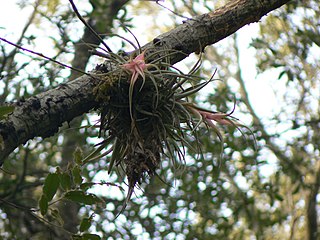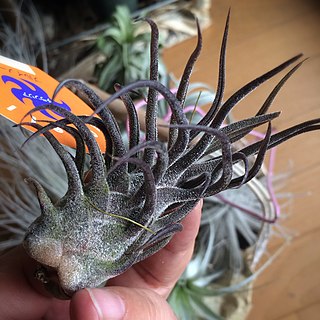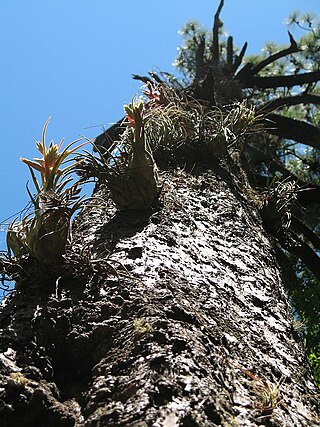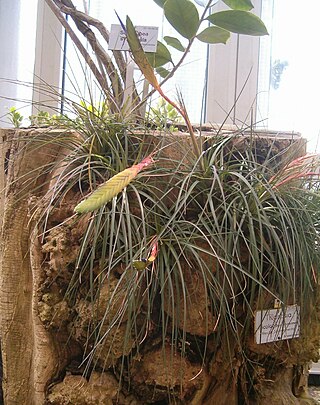
Tillandsia is a genus of around 650 species of evergreen, perennial flowering plants in the family Bromeliaceae, native to the forests, mountains and deserts of the Neotropics, from northern Mexico and the southeastern United States to Mesoamerica and the Caribbean to central Argentina. Their leaves, more or less silvery in color, are covered with specialized cells (trichomes) capable of rapidly absorbing water that gathers on them.

Tillandsia albida is a plant species in the genus Tillandsia. This species is endemic to Mexico.
Tillandsia botterii is a species in the genus Tillandsia. It is endemic to Mexico.

Tillandsia chiapensis is a species of flowering plant in the genus Tillandsia. This species is endemic to Mexico.
Tillandsia circinnatioides is a species of flowering plant in the genus Tillandsia. This species is endemic to Mexico.
Tillandsia crista-galli is a species of flowering plant in the genus Tillandsia. This species is endemic to Mexico. The specific epithet has also been spelt crista-gallii.
Tillandsia elizabethae is a species in the genus Tillandsia. This species is endemic to Mexico.

Tillandsia erubescens is a species of epiphytic plants of the genus Tillandsia. This species is endemic to Mexico, found over much of the country from Chihuahua to Oaxaca.
Tillandsia jaliscopinicola is a plant species in the genus Tillandsia. This species is endemic to Mexico.
Tillandsia socialis is a species of flowering plant in the genus Tillandsia. This species is endemic to Mexico. It was first described in 1958.

Tillandsia juncea is a species of flowering plant in the genus Tillandsia. This species is native to northern South America, Central America, Mexico and the West Indies.

Tillandsia pruinosa, is a species of flowering plant in the family Bromeliaceae. It is commonly known as the fuzzywuzzy airplant. This species is native to northern South America, Central America, southern Mexico, the West Indies and Florida.
Tillandsia compressa is a species in the genus Tillandsia. This species is native to Mexico, Colombia, Central America, and the West Indies.

Tillandsia fasciculata, commonly known as the giant airplant, giant wild pine, or cardinal airplant, is a species of bromeliad that is native to Central America, Mexico, the West Indies, northern South America, and the southeastern United States. Within the United States, this airplant is at risk of extirpation from the Mexican bromeliad weevil, Metamasius callizona. A related plant, Tillandsia utriculata, sometimes called the "wild pine", is endemic to the same areas.

Tillandsia flabellata is a species of flowering plant in the family Bromeliaceae. This species is native to southern Mexico and Central America.

Tillandsia ionantha, the air plant, is a species of plant in the genus Tillandsia. This species is native to Central America and Mexico. It is also reportedly naturalized in Broward County, Florida.
Tillandsia rotundata is a species of flowering plant in the family Bromeliaceae, native to Guatemala, Honduras and southeastern Mexico (Chiapas). It was first described by Lyman Bradford Smith in 1945 as the variety rotundata of Tillandsia fasciculata and raised to a full species by Cecelia Sue Gardner in 1984.

Tillandsia seleriana is a species of flowering plant in the genus Tillandsia. This species is native to southern Mexico and Central America.

Tillandsia streptophylla is a species of flowering plant in the genus Tillandsia. This species is native to Central America, Mexico, and the West Indies.

Tillandsia tricolor is a species of flowering plant in the genus Tillandsia. This species is native to Central America and Mexico.











